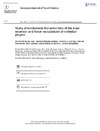Please use this identifier to cite or link to this item:
https://accedacris.ulpgc.es/jspui/handle/10553/45282
| Title: | Study of mechanical characteristics of the knee extensor and flexor musculature of volleyball players | Authors: | Rodríguez-Ruiz, David Rodríguez-Matoso, Dario Quiroga Escudero, Miriam Esther Sarmiento Montesdeoca, Samuel García Manso, Juan Manuel da Silvagrigoletto, Marzo E. |
UNESCO Clasification: | 241106 Fisiología del ejercicio | Keywords: | Tensiomyography Volleyball Muscle |
Issue Date: | 2012 | Publisher: | 1746-1391 | Journal: | European Journal of Sport Science | Abstract: | The aim of the present study was to analyse differences in muscle response and mechanical characteristics of the vastus medialis, rectus femoris, vastus lateralis, and biceps femoris in elite volleyball players of both sexes using tensiomyography. To this end, 47 players of nine nationalities playing for teams in the men's and women's Spanish Superleagues were assessed. The sample comprised 22 women (age 24.6±4.3 years; weight 72.14±10.06 kg; height 178.40±8.50 cm) and 25 men (age 25.0±4.3 years; weight 88.76±9.07 kg; height 194.71±7.84 cm). Tensiomyography was used to assess muscular response and muscular mechanical characteristics. For this purpose, the following variables were analysed: maximum radial displacement of muscle belly and normalized response speed. The findings show, both in men and women, a higher normalized response speed score in the vastus lateralis and vastus medialis compared with the rectus femoris and biceps femoris. A marked lateral symmetry of maximum radial displacement of the muscle belly was also observed in the musculature of the lower limbs, with no statistically significant differences being detected in either men or women. There were, however, clear differences in terms of normalized response speed between male and female volleyball players: women displayed a more pronounced difference in the normalized response speed of the musculature responsible for extension (vastus medialis, rectus femoris, and vastus lateralis) and flexion (biceps femoris) of the knee joint than men. Moreover, tensiomyography proved to be a highly sensitive tool for detecting such changes. | URI: | https://accedacris.ulpgc.es/handle/10553/45282 | ISSN: | 1746-1391 | DOI: | 10.1080/17461391.2011.568633 | Source: | European Journal of Sport Science[ISSN 1746-1391],v. 12, p. 399-407 |
| Appears in Collections: | Artículos |
SCOPUSTM
Citations
37
checked on Jun 8, 2025
WEB OF SCIENCETM
Citations
33
checked on Jun 8, 2025
Page view(s)
202
checked on Sep 27, 2025
Download(s)
534
checked on Sep 27, 2025
Google ScholarTM
Check
Altmetric
Share
Export metadata
Items in accedaCRIS are protected by copyright, with all rights reserved, unless otherwise indicated.
